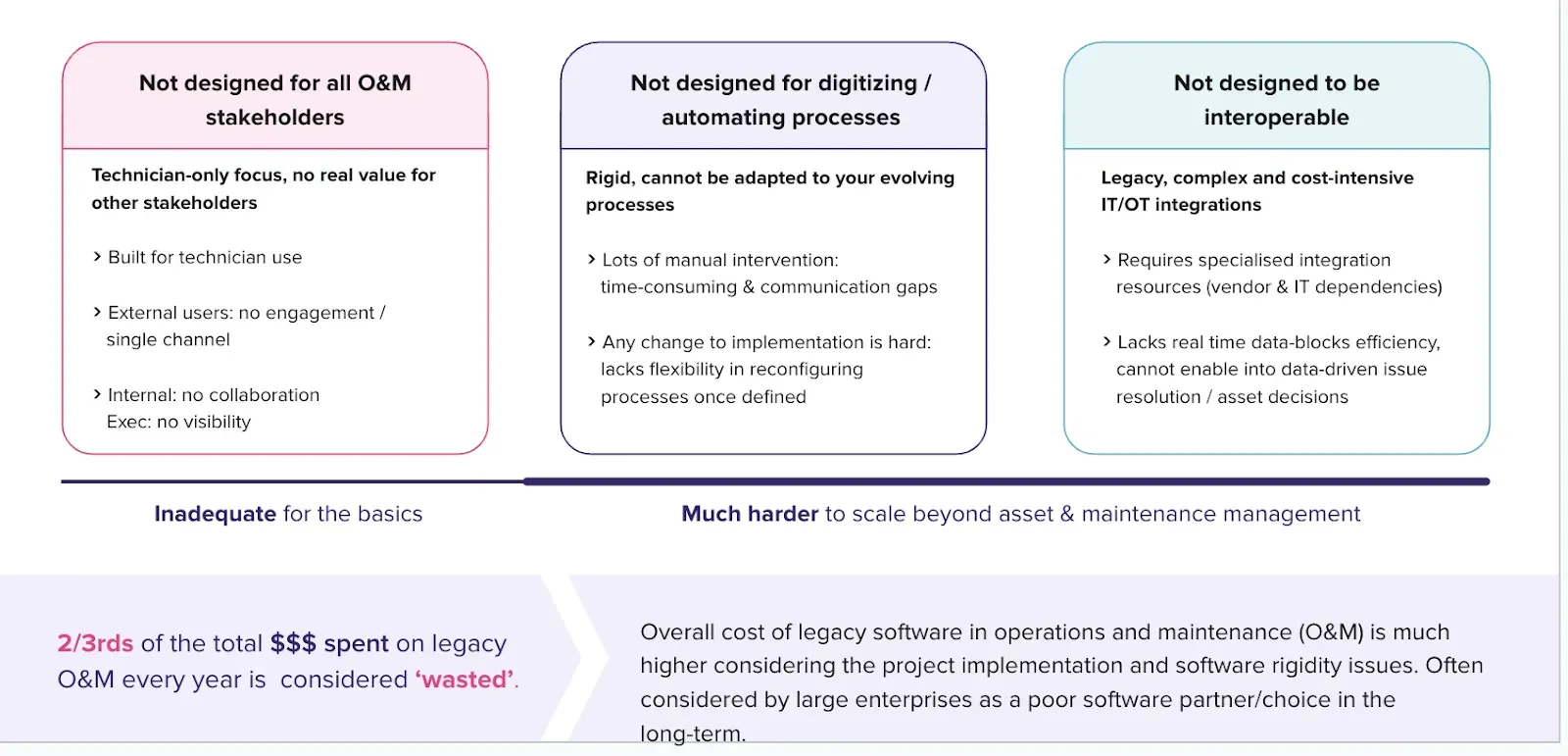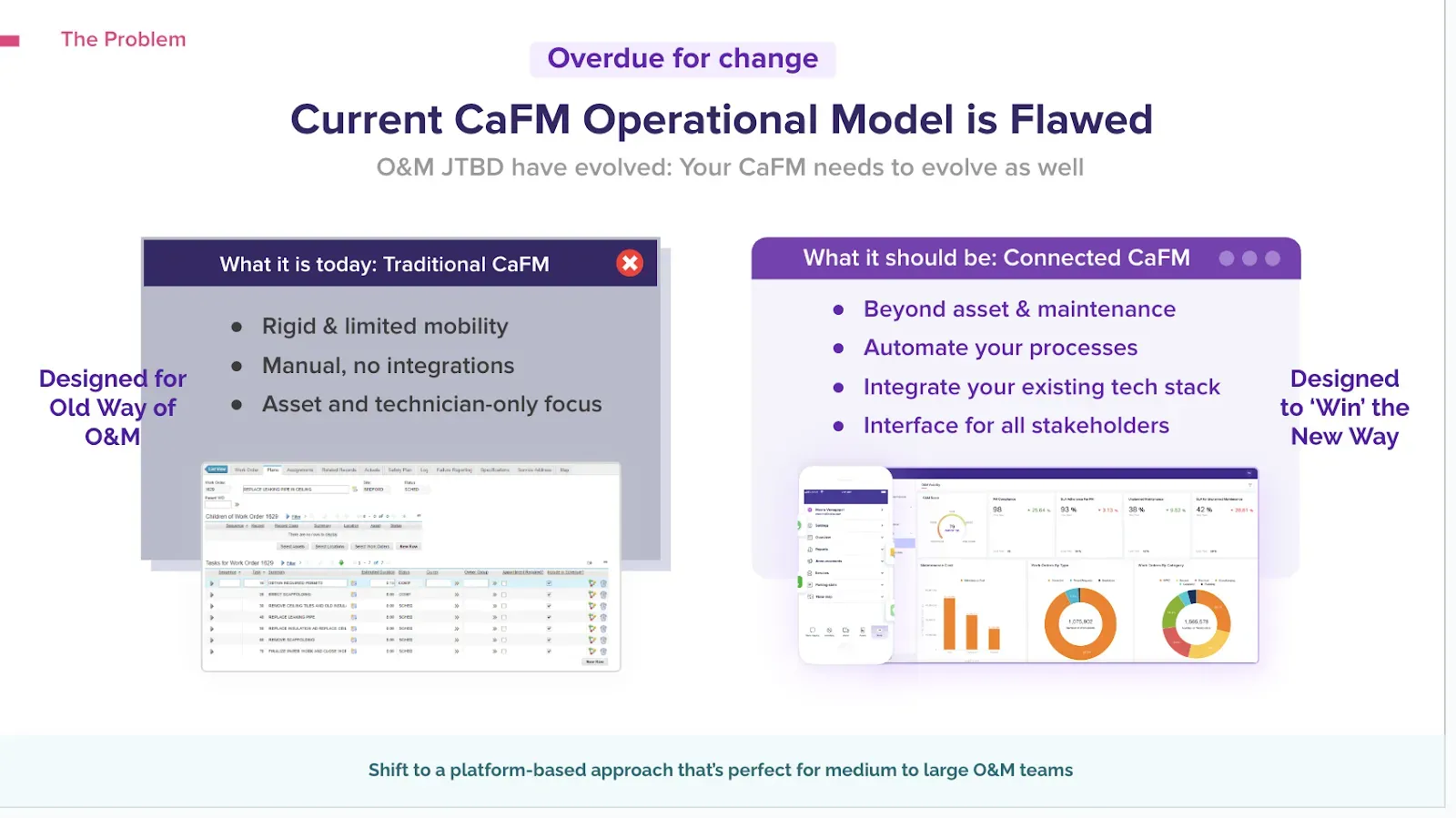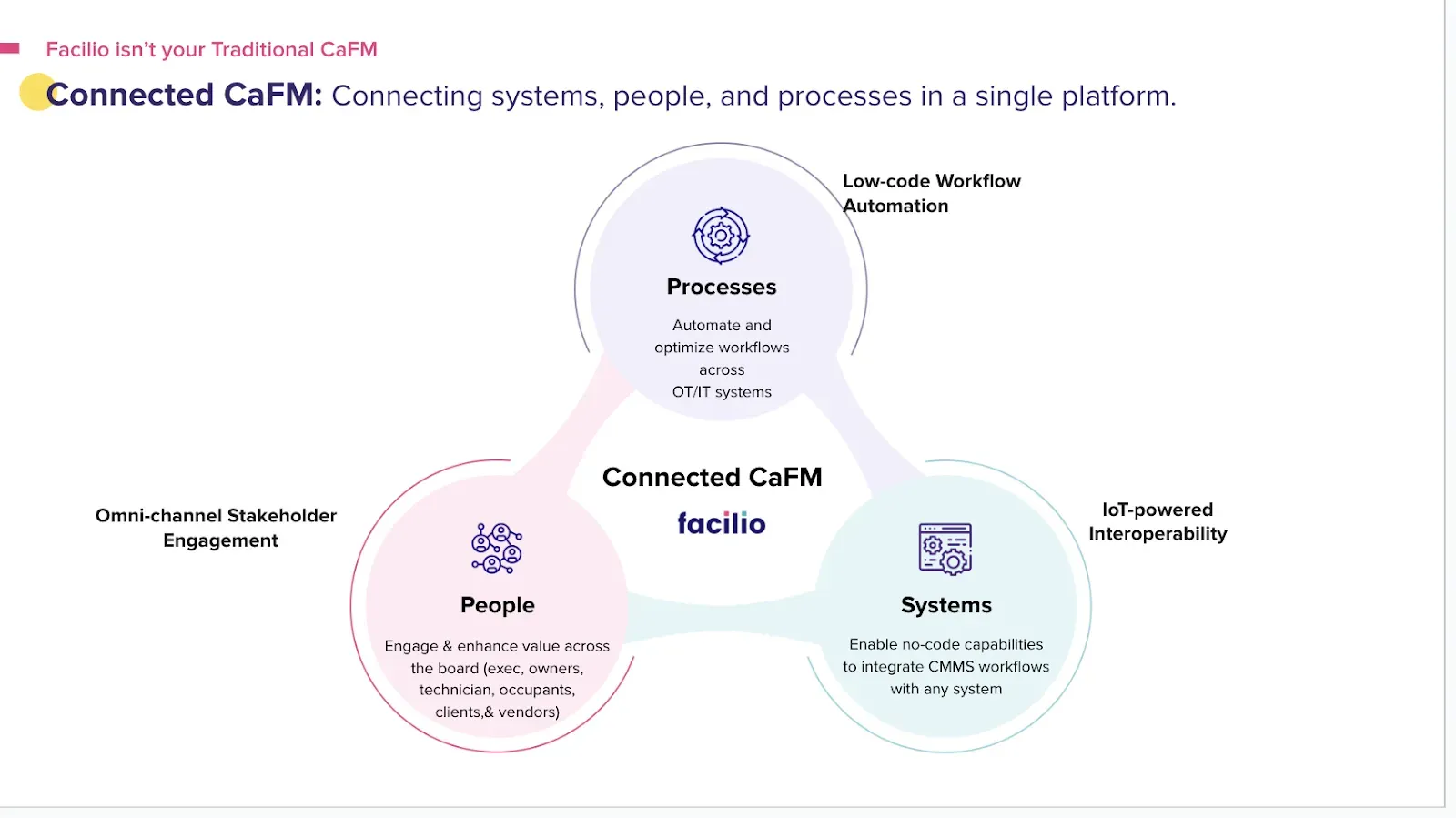What is CAFM?
CAFM stands for Computer-Aided Facility Management—a type of software that helps facility teams manage everything from maintenance and space planning to compliance and reporting, all in one place.
You can think of it as mission control for your building operations.
Instead of juggling spreadsheets, emails, and disconnected tools, CAFM software lets you:
- Track and maintain assets
- Schedule and manage work orders
- Monitor building systems
- Keep up with vendor SLAs and industry regulations
As workplaces become more complex, especially in regions like the U.S. and the U.K.—with hybrid work models, multi-location portfolios, and aging infrastructure—facility teams are under pressure to do more with less.
And that’s exactly where a CAFM comes in.
It gives teams the tools to stay ahead, whether you're managing a hospital in Texas, a corporate HQ in New York, or a university campus in California.
At the end of the day, CAFM facility management software empowers both your on-the-ground teams and senior decision-makers to work smarter—not harder—while keeping your facilities safe, efficient, and ready for what’s next.
Evolution of CAFM in facility management
Here's how CAFM evolved with time over the last five decades.

Why CAFM matters more than ever in facility management
CAFM software isn’t just a tech upgrade—it’s a strategic asset.
As facility operations become more complex and cost-driven, a well-implemented CAFM platform empowers executives to gain visibility, streamline operations, and make data-informed decisions that impact the bottom line.
- Disjointed systems drain resources: Siloed spreadsheets and outdated tools lead to duplicated efforts and inconsistent reporting.
- Maintenance inefficiencies add up: Unplanned downtime can cost businesses thousands per hour in lost productivity.
- Lack of visibility increases risk: Without centralized oversight, compliance gaps and safety issues go unnoticed until it’s too late.
- No clear ROI on assets: Aging infrastructure and poor asset tracking shorten equipment lifespan and inflate capital expenses.
- Operational data is underutilized: CAFM platforms transform raw data into actionable insights, making predictive maintenance possible. This approach can cut overall maintenance costs by 18–25% and reduce unplanned downtime by up to 50% (McKinsey & Company, 2020).
What makes a great CAFM software? List of key features that matter
Computer-aided facility management platforms are equipped with a suite of features designed to help facility leaders modernize operations, reduce costs, and enhance service quality.

Here’s a breakdown of the most essential capabilities grouped for clarity and strategic focus.
A) Core operational features
These are the foundational capabilities every CAFM system should offer to support day-to-day facility operations at scale.
- Asset management: Plan and track the complete lifecycle of assets—from procurement to disposal. Schedule preventive maintenance, monitor performance, and reduce downtime across your portfolio.
- Preventive maintenance scheduling: Automate all types of maintenance tasks, whether time-based, condition-based, or reactive. Assign work orders, set deadlines, and track completion with full visibility.
- Space and floor planning: Upload and manage digital floor plans to allocate space, plan renovations, and map asset locations. Ideal for optimizing usage in corporate offices, campuses, and healthcare facilities.
- Dashboards and reporting: Get real-time insights into asset performance, work order status, energy use, and cost trends. Customizable dashboards make it easy to share metrics with stakeholders or the C-suite.
B. Operational efficiency enhancers
These features help teams work faster, smarter, and more collaboratively by reducing manual effort and improving real-time responsiveness.
- Third-party vendor management: Centralize vendor information, track service agreements, and monitor SLA performance. Streamline collaboration and ensure accountability with external contractors.
- Mobile work execution: Empower field teams to access tasks, update work orders, and capture issues from anywhere. Mobile access reduces delays and improves first-time fix rates.
- Energy performance monitoring: Monitor energy usage across sites and benchmark performance. Identify inefficiencies, support sustainability goals, and drive cost savings through data-led decisions.
- Room and resource booking: Automate the booking of meeting rooms, shared spaces, and critical equipment. Eliminate double bookings and maximize space utilization with real-time availability.
C. Advanced and experience-driven features
These tools elevate service quality, compliance, and user experience, turning basic facility management into a strategic business enabler.
- Compliance and inspection management: Track regulatory requirements, automate inspection schedules, and log outcomes to ensure ongoing compliance. Reduce risk and improve audit readiness.
- Event and incident tracking: Log incidents, disruptions, or service events with full traceability. Analyze trends to prevent recurrence and improve response protocols.
- Occupant and tenant experience portal: Offer occupants and tenants a centralized portal to raise requests, track progress, and receive updates, improving transparency and satisfaction.
Who needs a CAFM?
A CAFM system software isn’t just for facilities teams—it’s a must-have for anyone responsible for managing buildings, compliance, or operations across the U.S. and beyond.
From hospitals and universities to corporate offices and government buildings, CAFM helps teams stay efficient, compliant, and ready for anything.

🛠 Facility Managers
In the U.S., facility leaders are under pressure to cut downtime, extend asset life, and stay ahead of maintenance demands. For instance, Limbach, a leading building systems firm, uses Facilio to manage HVAC and asset performance across healthcare and commercial properties, proving the power of connected operations.
👔 C-Level Executives
Executives need clarity and control. With Facilio, Investa unified siloed systems across a multi-site portfolio, boosting tenant satisfaction and enabling data-driven decision-making at the top level.
🏢 Property Owners & Landlords
Keeping assets profitable means staying on top of leases, vendors, and maintenance. Quality FM used Facilio to manage 1,500+ UAE properties—cutting customer escalations by 85%. The same approach fits REITs and commercial owners across the U.S.
🏥 Healthcare Admins
U.S. healthcare facilities must stay compliant with the Joint Commission and OSHA while running smoothly. Limbach’s deployment of Facilio in clinical settings shows how real-time insights can reduce risk and improve care environments.
🎓 Educational Institutions
U.S. school districts and universities are dealing with aging infrastructure and budget constraints. A major Melbourne university cut energy costs by 10–15% using Facilio—proof that smart campus ops work globally.
🏙 Corporate Real Estate Teams
Hybrid work, rising costs, and scattered portfolios call for smarter real estate strategies. Al Tayer and Investa used Facilio to centralize operations across dozens of sites—exactly what U.S. CRE teams need to stay agile.
🏛 Government Agencies
Civic buildings in the U.S. must meet strict codes and perform reliably. CIT Ltd digitized O&M for a large public-sector facility in just three weeks—proof that large-scale change is possible, fast.
Explore real-world success stories across healthcare, retail, and more.
[View all case studies →]
CAFM vs CMMS vs IWMS vs EAM: What’s the difference?
Choosing the right software platform is one of the most critical decisions for facilities and operations leaders.
Yet many teams still use terms like CAFM, CMMS, IWMS, and EAM interchangeably, leading to costly mismatches between tools and business goals.
CaFM vs CMMS vs IWMS vs EAM - Which one should you pick?
All these software have gentle but definite differences in terms of their day-to-day usage and use cases. Understanding the nuances between these terms is crucial for selecting the best fit for your organization's needs.

- CMMS (Computerized Maintenance Management System):
- Best for: Organizations prioritizing maintenance operations.
- Focus: Work order management, preventive maintenance scheduling, inventory tracking, and asset lifecycle management.
- EAM (Enterprise Asset Management):
- Best for: Organizations with extensive asset portfolios.
- Focus: Comprehensive asset management, including financial tracking, risk management, and regulatory compliance.
- CAFM (Computer-Aided Facility Management):
- Best for: CaFM fits well for organizations that are focused on space planning and utilization.
- Focus: Space management, move management, lease administration, and real estate portfolio management.
- IWMS (Integrated Workplace Management System):
- Best for: Organizations seeking a holistic approach to facility management.
- Focus: Combines the strengths of CMMS, EAM, and CAFM, offering a comprehensive solution for all facility-related needs.
The ideal choice depends on your day-to-day requirements and specific use cases:
- Small to medium-sized businesses may benefit from a simpler CMMS solution.
- Large enterprises with complex asset portfolios might opt for a comprehensive IWMS.
- Organizations with significant real estate holdings may prioritize a CAFM system.
Benefits of CaFM software in facility operations and management
CAFM software offers a vast array of benefits for organizations of all sizes. Here are some of the key advantages:
a) A CaFM helps you improve efficiency and become more productive
- Streamlined workflows: Automate routine tasks like work order generation, scheduling, and reporting.
- Enhanced communication: Centralized platform for seamless communication between facility teams and other stakeholders.
b) Optimize your asset management; integrate your inventory with work orders
- Predictive maintenance: Identify potential equipment failures and schedule preventive maintenance to extend asset lifespan.
- Inventory control: Track inventory levels, minimize waste, and reduce procurement costs.
- Asset lifecycle management: Monitor asset performance, track maintenance history, and plan for future replacements.
c) Achieve enhanced space utilization and move management
- Space planning and optimization: Visualize and analyze space usage to identify inefficiencies and optimize layouts.
- Move management: Streamline relocation processes and minimize disruption.
d) A CaFM lets you make informed decisions and mitigate risks
- Data-driven insights: Generate comprehensive reports and analytics to inform strategic decisions.
- Risk mitigation: Identify potential risks and implement preventive measures.
- Compliance adherence: Ensure compliance with industry regulations and standards.
e) Enhanced contractual management and reporting
- Centralized document sharing: Easily share and access asset-related documents with all stakeholders.
- SLA monitoring: Track service-level agreements to ensure vendors meet their contractual obligations.
- Vendor performance ratings: Store and review vendor ratings for better decision-making and collaboration.
How to choose the right CaFM system software: 6 crucial factors to consider
It's not feasible to list each element you need to consider when opting for such tools. So, instead, the basic rule is to assess your management needs first.
Besides that, here are a few other factors you should examine before buying such systems:
- Cloud vs. on-premise: Both cloud and on-premise CaFM systems come with their own advantages and limitations. According to Gartner, by 2025, over 85% of organizations are expected to prioritize a “cloud-first” strategy when implementing new IT infrastructure. Because cloud-based or web-based CMMS offers flexibility and remote access over on-premise systems that provide tighter control. Cloud options are also cost-effective upfront and follow the growing "cloud-first" trend.
- Integration with existing systems: Check if the CaFM software integrates well with your current tools. It should seamlessly connect with systems like ERP, HR, and IoT. Integration minimizes disruptions and boosts efficiency.
- Scalability for growth: Choose a system that can grow with your organization. It should ideally accommodate additional sites, users, and new operational needs without any significant disruptions.
- Ease of use and mobile access: Prioritize systems with user-friendly interfaces. The software should be easy to navigate for all stakeholders. Mobile accessibility is crucial for field teams and remote management.
- Security and compliance can’t be an afterthought: Ensure the system protects your facility and tenant data. Check that it meets regulatory standards for data security and compliance.
- Performance impact: At the end of the day, this isn’t just about features. Ask yourself: Will this actually make things better?
Can it reduce downtime?
And don’t just take the vendor’s word for it—ask for case studies, proof points, or even referrals. The right CAFM won’t just promise results. It’ll show them.
Speed up task closure?
Help you track SLAs?
Cut waste or energy bills?
And don’t just take the vendor’s word for it—ask for case studies, proof points, or even referrals. The right CAFM won’t just promise results. It’ll show them.
Check out our CAFM implementation checklist or request a custom demo to see how Facilio can actually support your long-term strategy.
CAFM pricing: How much does a CAFM system cost?
CAFM software pricing varies widely based on the size of your portfolio, the features you need, and how deeply you plan to integrate it into your operations.

Here's a general breakdown:
- Basic plans: Starting around $1,000/month, ideal for small teams managing a few sites with core features like asset tracking and work order management.
- Mid-tier solutions: Range from $5,000 to $15,000/month, offering advanced capabilities like preventive maintenance, energy monitoring, and mobile access.
- Enterprise-grade platforms: Start at $30,000/month and above, supporting large portfolios with IoT integration, custom workflows, AI-powered insights, and vendor management.
What impacts the cost?
- Number of facilities, users, and locations
- Advanced features (e.g., predictive maintenance, compliance automation)
- Custom integrations (with ERP, BMS, or IoT systems)
- Deployment model (cloud vs. on-premise)
- Support, onboarding, and training scope
For the most accurate estimate, request a tailored quote based on your needs and growth plans.
Why legacy CAFM no longer meets modern operational needs?
Traditional CAFM systems were built for a different era — one where maintenance was reactive, data was siloed, and only technicians needed access.

But today, facilities operations touch every layer of the organization. And legacy CAFM simply can't keep up.
- Technician-first design limits adoption: Legacy tools often neglect executives, finance leaders, and even facility managers who need intuitive dashboards, mobile access, and actionable insights, not just checklists and forms.
- Rigid architectures slow you down: Adapting to new business models or compliance requirements becomes a heavy lift, with limited configuration options and long lead times for change.
- Manual processes create inefficiency: From data entry to reporting, conventional systems are filled with handoffs, double work, and delays — all of which reduce productivity and increase operational costs.
- Integration is a pain point: Legacy platforms struggle to connect with ERP, HR, BMS, or accounting tools, leaving operations fragmented and decisions based on incomplete data.
- High cost, low return: Studies show that nearly two-thirds of O&M spending on legacy CAFM is wasted — a direct result of inefficiencies, lack of automation, and underutilized resources.

The bottom line?
Legacy CAFM isn’t just outdated — it’s actively holding businesses back.
To address these limitations, a more advanced "Connected CaFM" approach is needed.
Connected CAFM: A modern approach built for scale, agility, and outcomes
As discussed earlier, a Connected CAFM isn’t just an upgrade.
It’s a fundamental rethink of how facilities should operate in a fast-moving, data-driven world.
Instead of patching over legacy systems, a Connected CAFM — like Facilio’s Connected CAFM reimagines operations around three core pillars: people, processes, and systems.

- Connecting people: Empower everyone — from technicians and vendors to executives and tenants — to collaborate on a single, intuitive platform.
→ Result: Higher engagement, smoother communication, and faster resolutions. - Connecting processes: Unify every operational workflow — from maintenance and inspections to procurement and service requests — into one automated ecosystem.
→ Result: Fewer silos, greater efficiency, and stronger SLA performance. - Connecting systems: Seamlessly integrate your BMS, ERP, CRM, and IoT tools to create a live, shared source of operational truth.
→ Result: Data-driven insights, real-time visibility, and true portfolio-level control.

Where legacy CAFM is rigid, disconnected, and reactive, Connected CAFM is agile, unified, and intelligent. It’s not just about managing facilities. It’s about unlocking their full strategic value.
Ready to see what Connected CAFM can do for you?
Book a custom demo with our product expert today.
Frequently Asked Questions - CaFM
What is the difference between CaFM and CMMS?
CMMS focuses on asset management, tracking work orders, inventory, and maintenance schedules to reduce costs and extend asset lifecycles. It’s ideal for managing asset records and contractor data. CaFM goes further by providing insights into asset movement and optimizing space utilization, offering more comprehensive facility management.
What is the difference between CaFM and IWMS?
IWMS focuses on managing space, energy usage, and capital projects across multiple sites. It’s ideal for organizations with large portfolios. CaFM is better suited for managing a single site, offering administrative tools for asset and space management, but lacks the extensive multi-location capabilities of IWMS.
What is the difference between CaFM and IWMS?
IWMS software focuses on managing space, energy usage, and capital projects across multiple sites. It’s ideal for organizations with large portfolios. CaFM is better suited for managing a single site. It offers administrative tools for asset and space management, but lacks the extensive multi-location capabilities of IWMS.
What is the difference between CaFM and EAM?
EAM offers more robust asset management features, focusing on optimizing assets across an entire enterprise. However, it lacks the space management, energy monitoring, and rental capabilities that CaFM provides. CaFM combines asset management with specialized tools for space management and tfacility operations.
Get started now.
Let our product experts take you through our platform.

